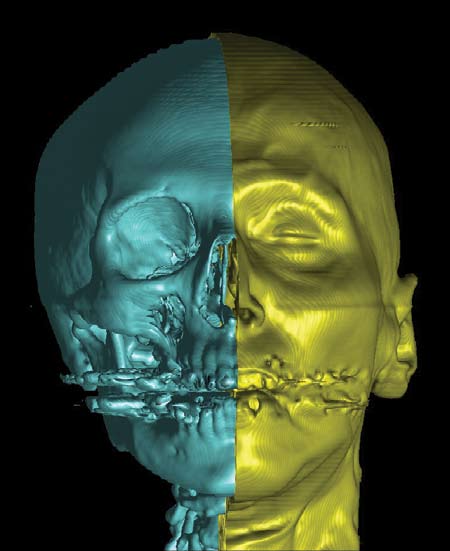below: Using OSC computers, Dr. Han-Wei Shen detected a symmetry plan from the data of a skull’s three-dimensional CT scan. He then applied different visualization techniques to the two halves of the skull.
Ohio State’s Graphics and Visualization Research Group embodies the proverb that “a picture is worth a thousand words.” These researchers specialize in scientific visualizations — the science of translating data analysis into cutting-edge renderings.
The graphics hardware market has advanced exponentially; commodity-based graphical processing units (GPUs) have become more programmable and easier to use for general applications. To empower research in this area, the Ohio Supercomputer Center’s GPGPU/Visualization Cluster provides 36 graphical processing units capable of 11,800 peak gigaflops. The cluster’s level of memory, speed and programmability is a necessity for realistic graphics.
“We have relied on the Ohio Supercomputer Center’s GPGPU/Visualization Cluster to develop high performance, scalable parallel visualization algorithms targeted at very large data sets, as well as verify our research results,” said Han-Wei Shen, Ph.D., an associate professor in computer science and engineering at The Ohio State University.
Parallel processing increasingly plays a more important role in the area of scientific visualization, especially as the size of data increases. Although many parallel visualization algorithms have been developed in the past, the complexity and scale of the data generated by terascale simulations demand even greater advancement in fundamental visualization algorithms and system designs.
Dr. Shen and his colleagues also tap OSC resources for flow visualization, timevarying data visualization and real-time applications, such as those used in medical surgical simulations. While each area uses different computational methods, all strive to create effective — and powerful — images to better illustrate the science behind the art.
--
Project lead: Han-Wei Shen, Ph.D., The Ohio State University
Funding source: Research supported in part by U.S. Department of Energy, Scientific Discovery through Advanced Computing, DE-FC02-06ER25779
